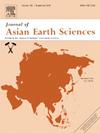HT-UHT metamorphism in the Dabie orogenic belt: A petrological study of garnet-plagioclaseamphibolite
IF 2.7
3区 地球科学
Q2 GEOSCIENCES, MULTIDISCIPLINARY
引用次数: 0
Abstract
The Dabie orogenic belt is pivotal for exploring ultrahigh-pressure (UHP) metamorphism. However, the occurrence of ultrahigh-temperature (UHT) metamorphism and its association with UHP metamorphism within this belt remain poorly constrained. Therefore, we conducted a detailed petrological investigation of garnet-plagioclase amphibolite from the Northern Dabie metamorphic belt, revealing five distinct metamorphic stages (M1, M2, M3-a, M3-b, and M4) with corresponding P-T conditions of 0.99 GPa/774 ℃, 0.75 GPa/766 ℃, 0.65 GPa/970–996 ℃, 0.65 GPa/824–854 ℃, and 0.27 GPa/737 ℃, respectively. Notably, the M3-a stage is identified as UHT metamorphism, supported by rare earth elements-based thermometry and the presence of amphibole symplectites (Amp = Cpx + Opx + Pl ± melt). Zircon U-Pb dating has yielded three age groups: Zrn-I (inherited magmatic zircons, 668–263 Ma), and the Zrn-II and Zrn-III groups (231 ± 3 Ma and 207 ± 3 Ma), with the latter two corresponding to the M1 and M2 metamorphic events. Furthermore, the protolith age of the granitic mylonite in structural contact with the garnet-plagioclase amphibolite was dated to 122 ± 1 Ma, indicating that the M4 event is contemporaneous or slightly older. The constructed P-T path reflects a gradual uplift process within the crustal level in the study area, involving isothermal decompression, isobaric heating, isobaric cooling, and decompression cooling. The transition from M1 to M3-b suggests initial uplift followed by termination, mirroring post-Triassic exhumation of the Dabie orogen, while the transition from M3-b to M4 may relate to Cretaceous extension.
求助全文
约1分钟内获得全文
求助全文
来源期刊

Journal of Asian Earth Sciences
地学-地球科学综合
CiteScore
5.90
自引率
10.00%
发文量
324
审稿时长
71 days
期刊介绍:
Journal of Asian Earth Sciences has an open access mirror journal Journal of Asian Earth Sciences: X, sharing the same aims and scope, editorial team, submission system and rigorous peer review.
The Journal of Asian Earth Sciences is an international interdisciplinary journal devoted to all aspects of research related to the solid Earth Sciences of Asia. The Journal publishes high quality, peer-reviewed scientific papers on the regional geology, tectonics, geochemistry and geophysics of Asia. It will be devoted primarily to research papers but short communications relating to new developments of broad interest, reviews and book reviews will also be included. Papers must have international appeal and should present work of more than local significance.
The scope includes deep processes of the Asian continent and its adjacent oceans; seismology and earthquakes; orogeny, magmatism, metamorphism and volcanism; growth, deformation and destruction of the Asian crust; crust-mantle interaction; evolution of life (early life, biostratigraphy, biogeography and mass-extinction); fluids, fluxes and reservoirs of mineral and energy resources; surface processes (weathering, erosion, transport and deposition of sediments) and resulting geomorphology; and the response of the Earth to global climate change as viewed within the Asian continent and surrounding oceans.
 求助内容:
求助内容: 应助结果提醒方式:
应助结果提醒方式:


